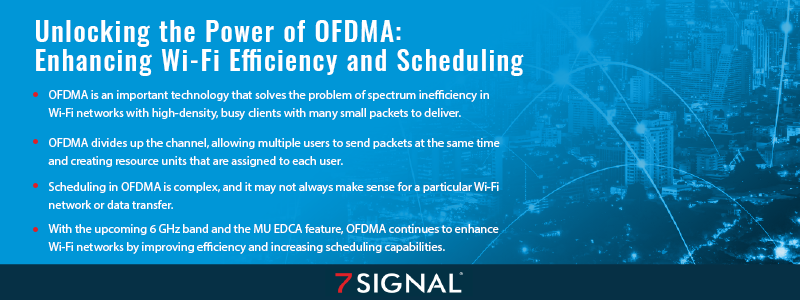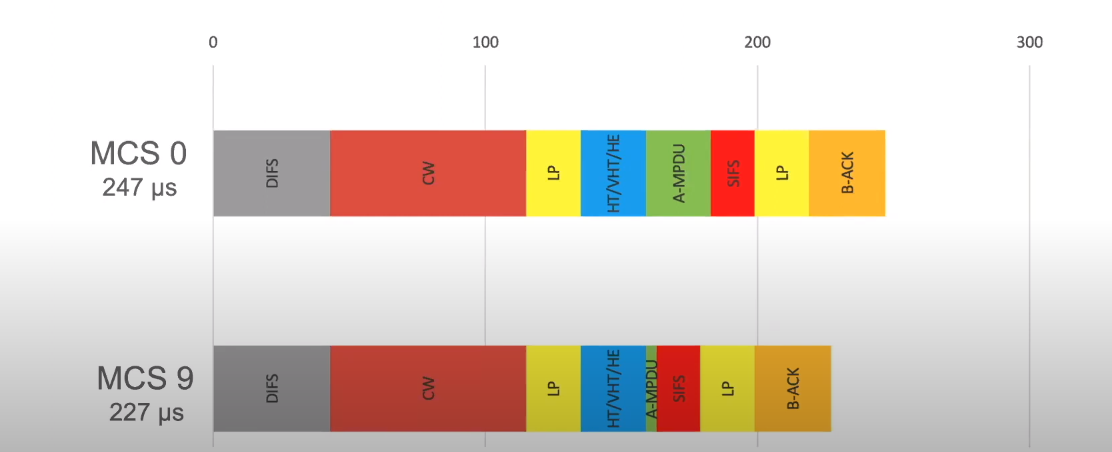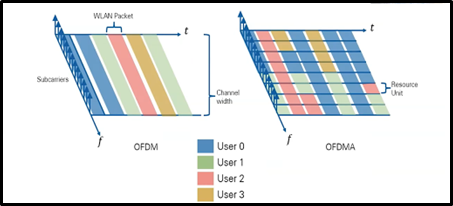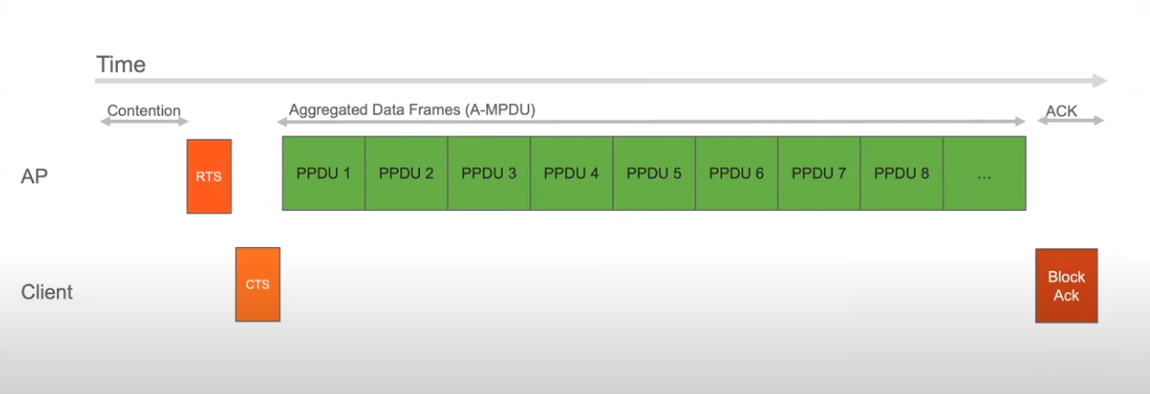
Blog

OFDMA (orthogonal frequency division multiplexing access) is a channel access method that continues to improve Wi-Fi, especially as Wi-Fi 6 becomes more widespread. In a recent webinar, we discussed OFDMA versus OFDM in Unlocking OFDMA.
The problem OFDMA solves
An ongoing problem with Wi-Fi has been that data rates have gotten faster as each new generation is released. This has made marketing numbers on the sides of AP boxes really high. It went from 1 megabit per second up to 10s of gigabits per second, theoretically, over the air with data rates.
When that happens, it’s optimizing the throughput that is possible to deliver to one client from an AP. However, what has not happened is increasing the number of packets delivered in a limited amount of airtime.
One example shows the amount of airtime it takes to send two frames. Both frames have a 300-byte payload, two spatial streams, normal guard interval, a 20 MHz channel, and a 12-megabit minimum basic rate. They are just sending one packet, so no RTS/CTS protection is necessary.

The first frame is at MCS 0, the slowest most clients will go, and transmitting that frame takes 247 microseconds. The second frame is at MCS 9, the fastest speed available for 802.11ac devices, yet it still requires 227 microseconds. That is only shaving off 20 microseconds between the two. Why is that?
The issue is with the channel access protocol and all the compatibility and legacy baggage Wi-Fi has accumulated over the years. The A-MPDU is the only part of this process that benefits from the higher data rate. It is the only part that shrinks slightly in the airtime consumption when you go to MCS 9.
The number of packets we can put through the air has not changed significantly throughout the history of Wi-Fi. It is not a problem with consumer devices or low-density networks – they are microseconds, so it is not a big deal if airtime is a bit wasteful.
However, it is a problem with very high-density, very busy clients with many packets to deliver. Most packets sent back and forth in Wi-Fi networks are small. Web browsing, email, messaging, voice, and even video are small packets. We have not really improved the handling of those small packets.
That is why OFDMA is important.
OFDM versus OFDMA: How they’re different
OFDM (orthogonal frequency-division multiplexing) is how everything has been modulated since 802.11a. With OFDM, one user, an AP or a client, transmits at a time and owns that whole channel. No one else can use it while using it, even if they are sending a small packet. It goes through the whole channel access procedure to get that packet across. It is wasteful from an efficiency perspective.

OFDMA is new to 802.11ax, and it is the main feature behind naming 802.11ax “high efficiency.” Instead of allowing a single user to dominate the whole channel at a time, you can divide up the channel. If you are just sending a small packet, you do not need 80 MHz. If there are a lot of clients that all want to send packets, OFDMA allows them to do it all at the same time and subdivide that channel. That subdivision creates resource units that are assigned to each user.
This is a significant change, and it is a proven technology that is now a couple of decades old. For instance, LTE and 5G use it. It is how cellular providers can have thousands of phones connected to a single tower and orchestrate all the traffic with a limited spectrum. It makes sense to adopt this in Wi-Fi and solve the problem of spectrum inefficiency.
Another unique thing to understand is that OFDMA is scheduled channel access. The AP schedules all this traffic and tells clients what resource units they transmit and when they will download frames. It is all under the control of the AP. The scheduler is the software the AP uses to make those decisions, and it has to account for the size of its buffer, what it knows about client buffers, channel conditions, and more.
One of the other benefits of OFDMA is that you can do channel access protocol less often. If clients transmit simultaneously during one period of OFDMA, the AP has to win channel access for that to happen once instead of each client having to win channel access individually.
The complexities of OFDMA
There is a lot of complexity in OFDMA, and the AP must determine if it should schedule. In 802.11ax, you still have all the legacy channel access procedures available to us, and you can still transmit one AP or client at a time, also known as single-user mode. OFDMA is in multi-user mode.
The AP has to answer whether it should schedule OFDMA or use MU-MIMO (multi-user, multiple input, multiple output) instead. In addition, the AP can operate in unscheduled single-user mode.
Today’s APs rarely schedule ODFMA for these common reasons:
- APs compete equally with legacy clients for channel access.
- Legacy clients cannot participate in scheduled access.
- Only buffered frames to or from 802.11ax clients can be scheduled.
- Wi-Fi is faster in single-user mode.
- The single-user mode has had some efficiency gains because of frame aggregation.
- Good WLAN designs optimize channel access, so there is often no congestion.
- The schedulers and protocol may not be fully baked yet.
- Scheduling software is proprietary. The 802.11ax standard doesn’t dictate how a scheduler makes decisions; it just provides the tools to use.
These reasons mean that OFDMA does not always make sense for a particular Wi-Fi network or data transfer.
Scheduling is tricky
Scheduling in wireless networks is tricky; a recent trivia question exemplifies this. The question asks what mode of operation will consume the least airtime in a scenario where an 802.11ax AP with four spatial streams and a 20 MHz channel width needs to send each of its eight connected clients 80KB of data.
The answer may seem to be OFDMA, but it is unscheduled single-user transmissions.
While most people would assume that OFDMA is the best choice in this scenario, single-user mode would consume less airtime.
This example is from the book Wi-Fi 6 Protocol and Network by two wireless networking experts. The book provides detailed explanations of scheduling and other wireless networking concepts.
Frame aggregation

One of the benefits of using unscheduled single-user transmissions is the efficiency of frame aggregation. In single-user mode, every data frame is centered in an aggregated frame format called AMPDU.
This aggregation method is particularly useful for clients that require large amounts of data. Instead of going through the channel access procedure multiple times, the AP can use AMPDU to send frames one after another until the buffer is emptied.
This makes single-user mode a good choice in many cases, and highlights the potential benefits of AMPDU.
Increasing scheduling
As Wi-Fi technology advances, so does the need for better channel access scheduling. One way to increase scheduling is through the use of Dynamic Frequency Selection (DFS) and Transmit Power Control (TPC) in the Dedicated Short Range Communications (DSRC) spectrum. In addition, the upcoming 6 GHz band offers even more opportunities for increased scheduling.
One of the biggest advantages of the 6 GHz band is the lack of legacy interference from previous generations of Wi-Fi. This means that all clients on the network will be 802.11ax, allowing the Access Point (AP) to dominate channel access. Wider channels in the 6 GHz band also means that more simultaneous clients can be scheduled at once, with 80 MHz being the default channel width in many enterprise networks. Eventually, 320 MHz channel widths may also become available.
In the 6 GHz band, the AP can schedule up to 37 clients at a time using OFDMA. This is a significant improvement over the 20 MHz channel width commonly used in the 2.4 GHz and 5 GHz bands, limiting the number of users scheduled at once.
The Multi-User Enhanced Distributed Channel Access (MU EDCA) feature is another way to increase scheduling. This feature uses a different set of EDCA parameters for clients already scheduled for uplink OFDMA. This gives the AP a higher likelihood of winning channel access, forcing clients to be scheduled for channel access rather than contending for it. These parameters can be aggressive in the 6 GHz band due to the lack of legacy interference. However, not all AP vendors allow for the customization of these parameters.
Role of OFDMA in enhancing Wi-Fi efficiency and scheduling
OFDMA is a crucial technology that improves the efficiency and speed of Wi-Fi networks. With Wi-Fi technology advancing, the need for better channel access scheduling is increasing.
With the upcoming 6 GHz band, the lack of legacy interference and wider channels will allow even more simultaneous clients to be scheduled. The MU EDCA feature can further increase scheduling. Ultimately, OFDMA remains a valuable technology that continues to enhance Wi-Fi networks, especially as Wi-Fi 6 becomes more widespread.
How 7SIGNAL helps Wi-Fi performance
The 7SIGNAL team helps a variety of industries plan and monitor wireless networks to improve Wi-Fi performance for the end user. With the 7SIGNAL Platform, you can constantly test your Wi-Fi, collect important data, and monitor how users are experiencing the connection at all times.
Get in touch to learn more.
7SIGNAL® is the leader in wireless experience monitoring, providing insight into wireless networks and control over Wi-Fi performance so businesses and organizations can thrive. Our cloud-based wireless network monitoring platform continually tests and measures Wi-Fi performance at the edges of the network, enabling fast solutions to digital experience issues and stronger connections for mission-critical users, devices, and applications. Learn more at www.7signal.com.